A historical account of the Hoysala Dynasty
- In History & Culture
- 12:13 AM, Mar 02, 2016
- Suresh S Murthy
The Hoysala Empire was a prominent Southern Indian Kannadiga empire that ruled most of the modern-day state of Karnataka between the 10th and the 14th centuries.
The Hoysalas are remembered for their patronage to arts along with their exploits on the battlefield – a baffling 1500 temples built in 958 centers, of which the two famous ones are Belur and Halebidu which were the capital cities of the dynasty. However, hardly a 100 survive today. Well known temples which exhibit an amazing display of sculptural exuberance include the Chennakesava Temple at Belur, the Hoysaleswara Temple at Halebidu, and the Chennakesava Temple at Somanathapura.
The Legend
According to Kannada folklore, a young man named Sala, who saved his Jain guru Sudatta by striking dead a Lion he encountered near the temple of the Goddess Durga or Vasantha Parameshwari at Angadi, now called Sosevuru. The word "strike" literally translates to "hoy" in Hale Kannada (Old Kannada), hence the name "Hoy-sala".
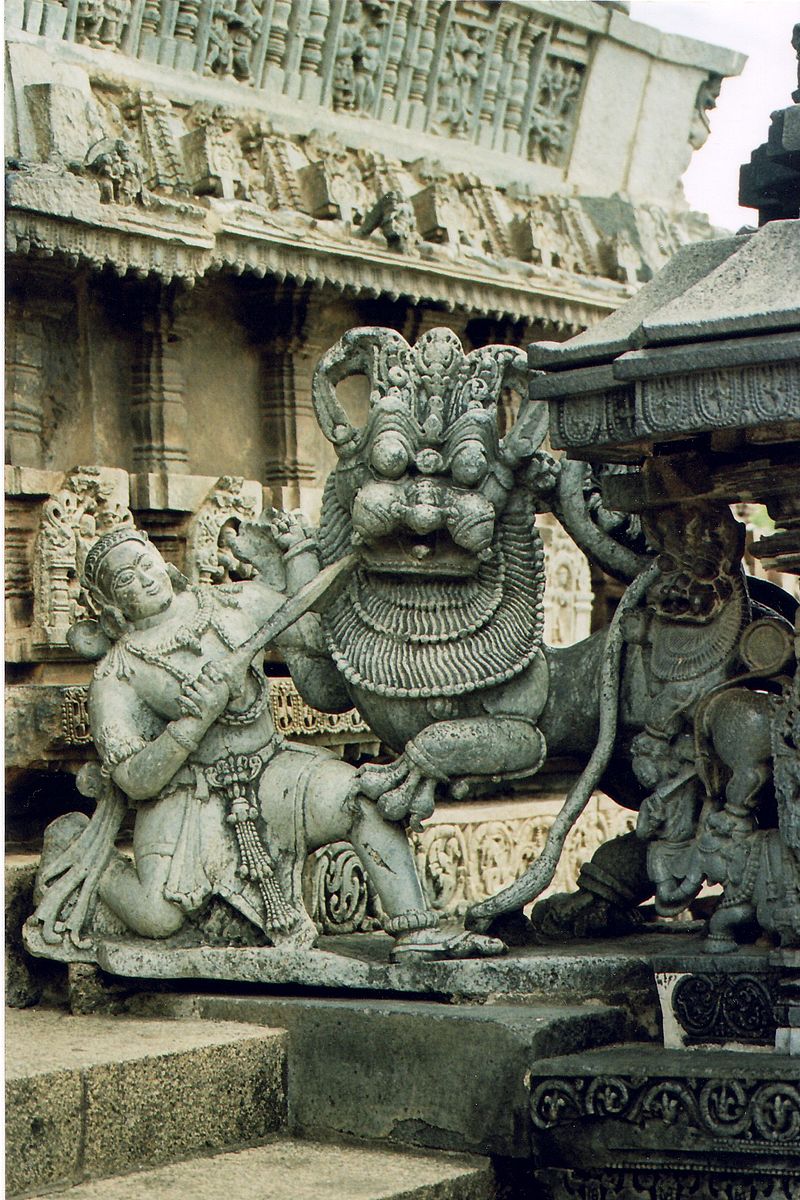
Photo courtesy: The Hoysala Symbol - with founder Sala and the Tiger
This legend first appeared in the Belur inscription of Vishnuvardhana (r. 1108 – 1152), but owing to several inconsistencies in the Sala story, it remains in the realm of folklore.
The legend may have come into existence or gained popularity after King Vishnuvardhana's victory over the Cholas at Talakad as the Hoysala emblem depicts the fight between the mythical warrior Sala and a tiger, the tiger being the emblem of the Cholas. Historians claim that the story behind the Hoysala crest is a symbolic interpretation of this victory as the tiger; a symbol of the Cholas is shown subdued by a soldier.
Origin
Journey of the Hoysalas began about 1000 years ago and lasted roughly from 1000 C.E to 1346 C.E. They were not born rulers and still they went onto rule for 300 years!
Early inscriptions, dated 1078 and 1090, have implied that the Hoysalas were descendants of the Yadava by referring to the Yadava vamsa (clan) as Hoysala vamsa. But there are no early records directly linking the Hoysalas to the Yadavas of North India.
Historians refer to the founders of the dynasty as natives of Malenadu in Karnataka, based on numerous inscriptions calling them Maleparolganda or "Lord of the Male (hills) chiefs" (Malepas). This title in the Kannada language was proudly used by the Hoysala kings as their royal signature in their inscriptions. Literary sources from that time in Kannada (Jatakatilaka) and Sanskrit (Gadyakarnamrita) have also helped confirm they were natives of the region known today as Karnataka.
Hoysalas were initially tribal chiefs who were subordinates of the Western Chalukyas, sandwiched between the Cholas to the south and the Badami Chalukyas in the north. They had a difficult time to keep their kingdom intact. But this did not affect their prosperity and administrative stability. Like most kings from Karnataka, Hoysalas were famous for their religious tolerance.
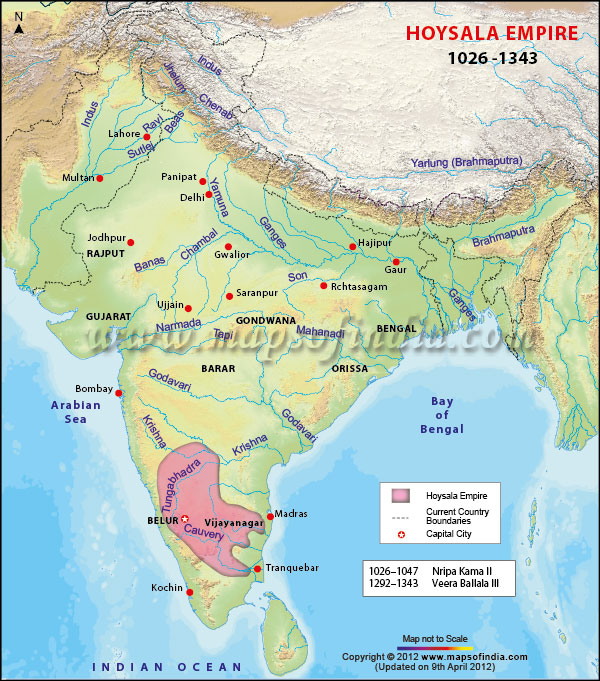
Photo Courtesy: Hoysala Empire
The untold story of Hoysaleshwara Vishnuvardhana
Vishnuvardhana (r.1108–1152 CE) was the most prolific king of the Hoysala Empire, in what is today the modern state of Karnataka, India.
He ascended the Hoysala throne after the death of his elder brother Veera Ballala I in 1108 C.E. Originally a follower of Jainism and known as Bitti Deva, he came under the influence of the Hindu philosopher Ramanujacharya, converted to Hindu Vaishnavism and took the name "Vishnuvardhana".
Victories in the South
Vishnuvardhana was the governor over parts of Gangavadi during the rule of his elder brother Veera Ballala I. After ascending the Hoysala throne, his first major conquest was that of the occupied Chola territories of Gangavadi in 1116 C.E.
His winning streak included the victory over the rulers of the Nilgiri region, such as the Chengalvas, the Kongalvas (resulting in his marriage to the Kongalva princess Chandaladevi), and the Nidugal Chola ruler Irukkavela. Vishnuvardhana's forces marched as far as Kanchi. The Nolambas of Nolambavadi, Kadambas of Banavasi and Goa (ruled by Jayakesi II), and Pandyas of Uchchangi (a small dynasty of rulers near the Tungabhadra), the Alupas of Tulunadu, and the Santaras of Hosagunda had to pay tribute and accept Vishnuvardhana as their overlord.
Vishnuvardhana was responsible in part for the disruption to the Chola Empire. With these victories, Vishnuvardhana assumed the titles Talakadugonda ("Lord of Talakad”) and Nolambavadi gonda ("Lord of the Nolambas").
Victory over the Kalyani Chalukyas
After his successes in the south, Vishnuvardhana swiftly turned north with the intention of breaking free from his overlord, the great Western Chalukya King Vikramaditya VI. Between 1117 C.E. and 1120 C.E., Vishnuvardhana successfully dealt with the Chalukyan armies at Kannegala (1118 C.E.), occupied a strategic fort at Hanagal, defeated the Chalukyan commander Boppanna at Hallur (c.1120) and spread his control over the Banavasi and Humacha regions.
By 1122 C.E., he had reached the Krishna River where he was defeated by the powerful Sinda chief Achugi, a commander loyal to the Chalukya emperor. Vishnuvardhana thus had to accept, for the time being, subordination to the Chalukya throne.
But he was not to be subdued for long. After the death of Vikarmaditya VI, the Hoysala monarch re-captured Hanagal, Uchchangi and Bankapura by 1140 C.E. and marched north of the Tungabhadra river up to Lakkundi. Vishnuvardhana controlled areas in the Krishna river region even around 1131 C.E. and performed the prestigious Tulapurusha ceremony, a symbol of sovereignty, despite his nominal subordination to the Chalukyas. It is believed that after declaring sovereignty Vishnuvardhana assumed the name Hoysaleshwara Vishnuvardhana.
Architectural Legacy
Vishnuvardhana was a great builder. To celebrate his success against the Cholas, he built the Keerthi Narayana temple at Talakad, and the spectacular Veeranarayana temple at Belur (also called the Chennakesava Temple, dedicated to the Hindu god Vishnu). Around the same time, the Hoysaleswara temple, more ornate than the one at Belur and dedicated to the Hindu god Shiva was consecrated. Within the Chennakesava temple complex is the smaller yet ornate Kappe Chennigaraya temple built by Vishnuvardhana's noted queen Shantaladevi.
A beautiful documentary on the life and work of Hoysaleshwara Vishnuvardhana can be viewed here.
Administration
The framework of Hosalya Dynasty was inherited from Chalukyas. The Hosalyas divided the kingdom into Nadus, Kampanas, Vishayas and Deshas. There were officers designated at different levels to run the administrative machinery.
The Hoysalas also had an elite and well trained force of bodyguards known as Garudas protected the members of the royal family at all times. Hero stones (virgal) erected in memory of these bodyguards are called Garuda pillars. The Garuda pillar at the Hoysaleswara temple in Halebidu was erected in honor of Kuvara Lakshma, a minister and bodyguard of King Veera Ballala II.
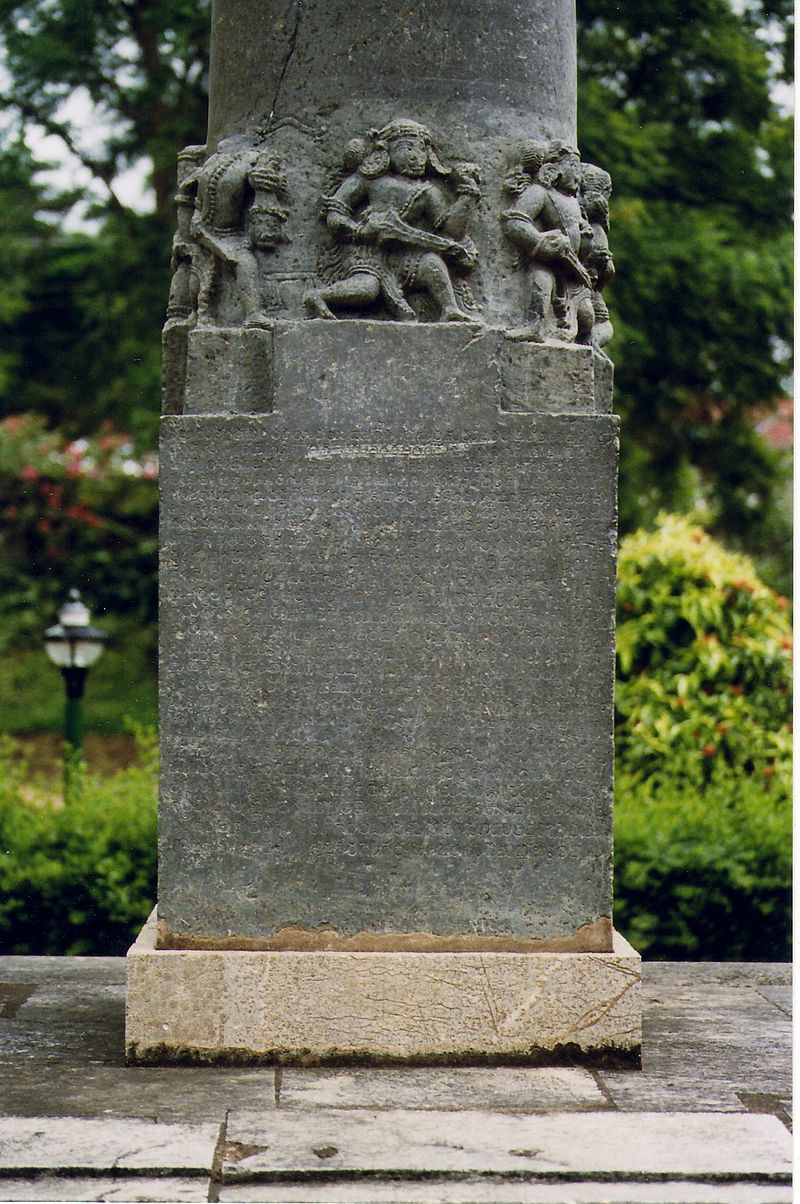
Photo courtesy: Garuda pillar hero stone at Halebidu
Economy
The Hoysala administration supported itself primarily through revenues from an agrarian economy. The kings gave grants of land as rewards for service to beneficiaries who then became landlords to tenants producing agricultural goods and forest products.
Importing horses for use as general transportation and in army cavalries of Indian kingdoms was a flourishing business on the western seaboard.
Architects (Vishwakarmas), sculptors, quarry workers, goldsmiths and other skilled craftsmen whose trade directly or indirectly related to temple construction were also prosperous due to the vigorous temple building activities.
The taxation policy of the Hoysala empire included land revenue called Siddhaya and included the original assessment (Kula) plus various cesses. Taxes were also levied on professions, marriages, goods in transit on chariots or carriages, and domesticated animals. Taxes on commodities as well as produce are noted in village records.
Temple Architecture
One of the most striking features of Hoysala architecture is its attention to exquisite detail and skilled craftsmanship. The Hoysalas usually dedicated their temples to Shiva or to Vishnu (two of the popular Hindu gods), but they occasionally built some temples dedicated to the Jain faith as well.
Generally Vaishnava temples are dedicated to Keshava (or to Chennakeshava, meaning "Beautiful Vishnu") while a small number are dedicated to Lakshminarayana and Lakshminarasimha (Narayana and Narasimha both being Avatars, or physical manifestations, of Vishnu) with Lakshmi, consort of Vishnu, seated at his feet.
The focus of a temple is the centre or sanctum sanctorum (garbagriha) where the image of the deity resides, so temple architecture is designed to move the devotee from outside to the garbhagriha through ambulatory passageways for circumambulation and halls or chambers (mantapas) that become increasingly sacred as the deity is approached.
Most Hoysala temples have a plain covered entrance porch supported by lathe turned (circular or bell-shaped) pillars which were sometimes further carved with deep fluting and molded with decorative motifs. The temples may be built upon a platform raised by about a metre called a "jagati". The jagati, apart from giving a raised look to the temple, serves as a pradakshinapatha or "circumambulation path" for circumambulation around the temple, as the garbagriha (inner sanctum) provides no such feature. Such temples will have an additional set of steps leading to an open mantapa (open hall) with parapet walls. The jagati which is in unity with the rest of the temple follows a star-shaped design and the walls of the temple follow a zig-zag pattern, a Hoysala innovation.
More detailed account Hoysala architecture can be found here. It explains in great detail the architecture style, the temple deities, the craftsmanship, etc.
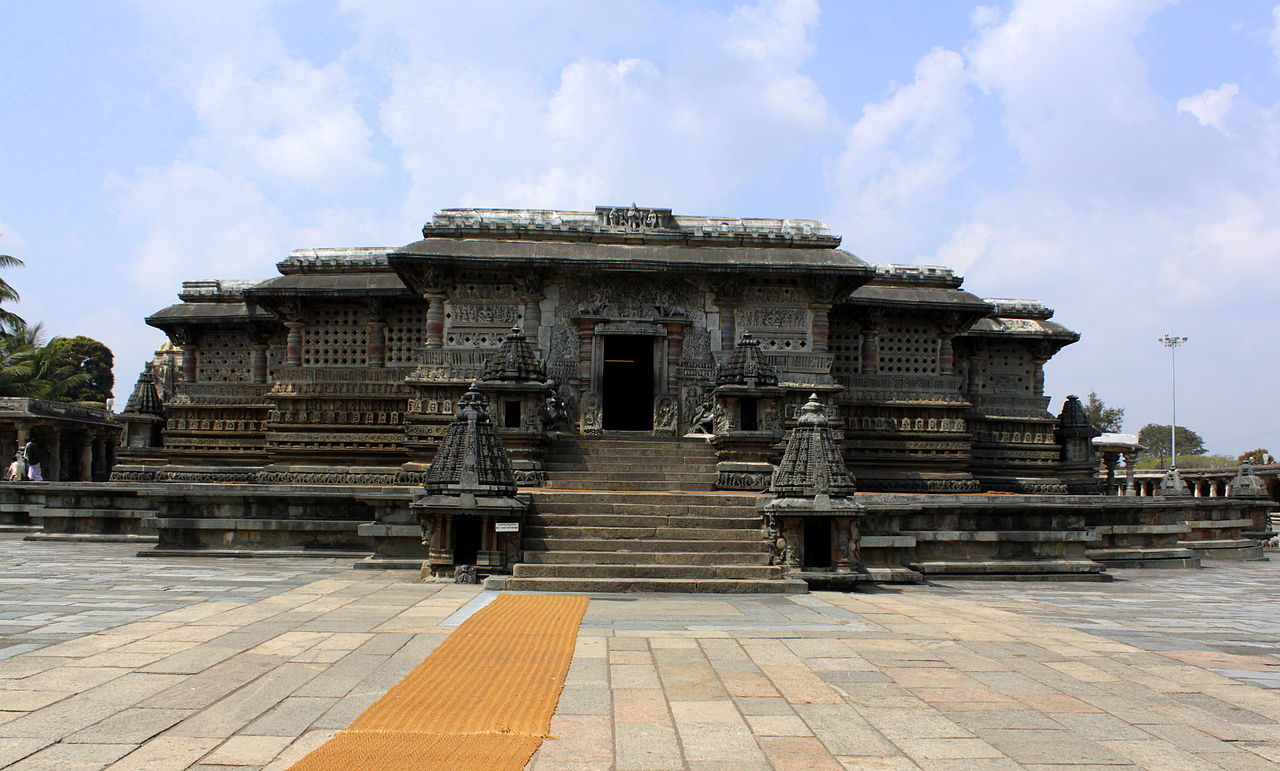
Photo courtesy: Chennakeshava Temple, Belur
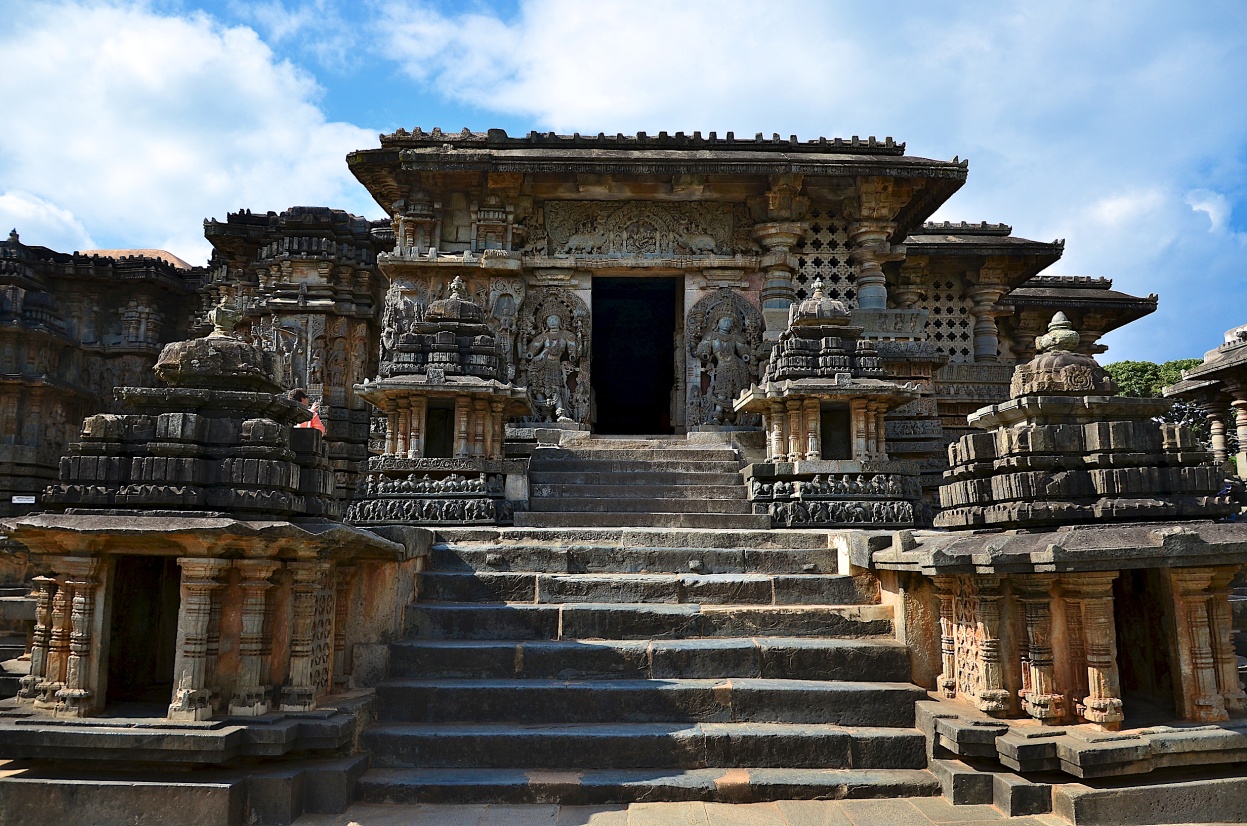
Photo Courtesy: Hoysaleshwara Temple, Halebidu
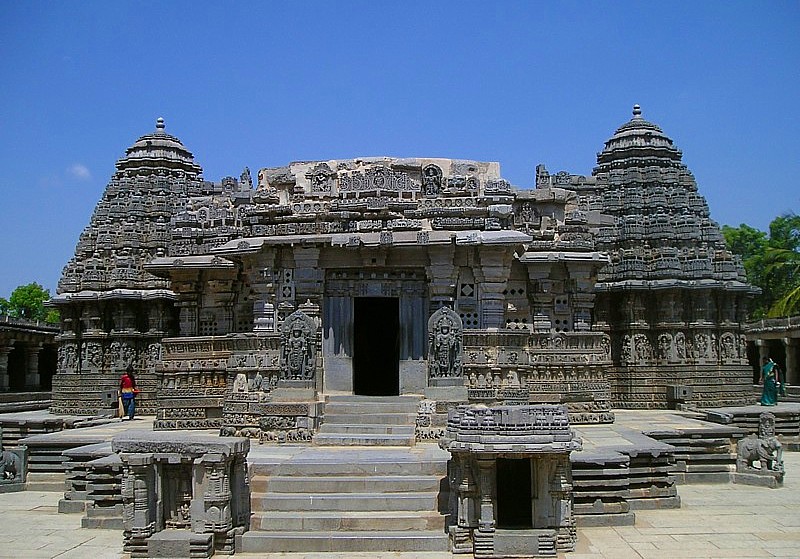
Photo Courtesy: Chennakeshava Temple, Somanathapura
Decline of the Hoysala Empire
Major political changes were taking place in the Deccan region in the early 14th century when significant areas of northern India were under Muslim rule. Alla-ud-din Khilji, the Sultan of Delhi, was determined to bring South India under his domain and sent his commander, Malik Kafur, on a southern expedition to plunder the Seuna capital Devagiri in 1311. The Seuna Empire was subjugated by 1318 and the Hoysala capital Halebidu (also called Dorasamudra or Dwarasamudra) was sacked twice, in 1311 and 1327.
By 1336, the Sultan had conquered the Pandyas of Madurai, the Kakatiyas of Warangal and the tiny kingdom of Kampili. The Hoysalas were the only remaining Hindu empire who resisted the invading armies. Veera Ballala III stationed himself at Tiruvannamalai and offered stiff resistance to invasions from the north and the Sultanate of Madurai to the south. Then, after nearly two decades of resistance, Veera Ballala III died at the battle of Madurai in 1343 and the sovereign territories of the Hoysala Empire merged with the areas administered by Harihara I in the Tungabhadra region. That new Hindu kingdom resisted the northern invasions, later prospering as the Vijayanagara Empire.







Comments